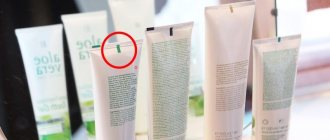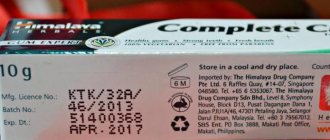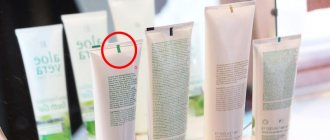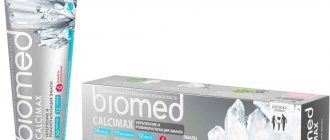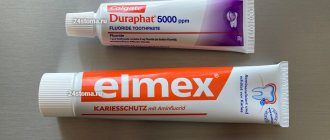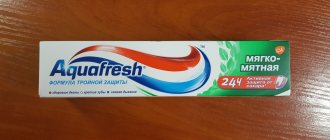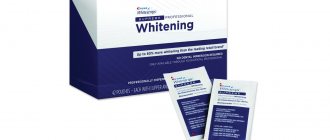July 28, 2019
Today on the shelves of stores and pharmacies there are a large number of products intended for hygiene and oral care. And, naturally, before making a choice, we are all interested in the quality of the product, its composition and how safe it is. We want to know as much useful information as possible, which is why we sometimes look for hidden subtext even where there is actually none. For example, many people are interested in what the stripes on toothpaste tubes mean. Journalists from the portal UltraSmile.ru also asked themselves this question and conducted a small investigation. You will find details in our material today.
Are all pastes color coded?
We'll tell you a secret - stripes are found not only on toothpaste, but also on any tube that contains creams, gels or any other cosmetic products. And these marking stripes can be of completely different colors (red, green, blue, black) and even shapes (square, rectangular), but are invariably localized on the tail of the tube.
Stripes are found not only on toothpaste, but also on other tubes
Naturally, most consumers have a question - what can color markings mean? Maybe she reveals to us secret information or an important message that will warn us against buying or, conversely, tell us about the miraculous properties of this product? Let's figure it out together.
Alternative theory
mythological meaning is sometimes attributed to flowers on toothpaste :
- Black: composition for whitening tooth enamel. Recommended for use no more than once a week;
- Blue: the mass is suitable for everyday use;
- Red: there is a healing effect. Such products are sold in pharmacies and prescribed by dentists in case of painful teeth;
- Green: designed to consolidate the healing results achieved by the previous composition. Recommended for use within 4 weeks after the treatment course.
Other decryption options are also possible. The gradation of colors is often interpreted as a distribution by price categories of goods, where the green marker is an indicator of an elite and expensive “eco-product”.
The contents of the tube and its color: is there a relationship?
Many Internet users still believe that the colored stripes on toothpaste have something to do with the contents of the tube. For example, this is a designation of the harm or benefit of the ingredients included in the composition. However, this opinion is wrong. You will find out further how things really work out. And now we present to you a selection of the most ridiculous interpretations that can be found on the Internet about what the colored stripe on toothpaste means.
Read the article on the topic: 6 tips to help you choose the perfect toothpaste.
What does the square on a tube of toothpaste mean?
This label does not provide any information about the composition of the product. Similar colored squares are found on milk cartons, waffles or cookies, and other food packaging. Their presence is due to only one thing - simplifying the process of cutting packaging material.
Multicolored
Squares of different shades on the packaging signal the machine to start the action, where it should make a cut and where to seal the tube. The choice of specific color depends on the manufacturer. Usually choose bright, rich or dark colors. The machine recognizes them quickly and accurately.
Toothpaste with green square
Our associative life experience inspires the subconscious that the pasta with a green square contains exclusively natural ingredients. In fact, such markings have nothing to do with the derivatives of the tube, and the toothpaste in it may contain synthetic components.
This is interesting: Tooth cyst
Myth No. 1: a color marker signals the harm or benefit of the composition
- green: this is a natural product that contains environmentally friendly ingredients,
- what does the red stripe on toothpaste mean: such products are full of ingredients and substances that are dangerous to the health of the body and oral cavity,
- blue: the product contains synthetic substances, but they are not dangerous to health or life, because their use in a certain ratio is permitted,
- what does a black stripe on toothpaste mean: such a product is very dangerous, and it may also contain substances that provoke gum inflammation, gingivitis, periodontitis and periodontal disease.
There are myths that the strips symbolize the dangers and benefits of the product
Why do we mark the adhesion site?
Let's say right away that marked squares or rectangles of different colors have nothing to do with the quality characteristics of the toothpaste.
The same marks can be found on creams and other products in tubes or sealed bags. Multi-colored markers serve as technological markings. The products are packaged using robotic equipment. It is labeling that allows you to automate the process and eliminate human participation.
Before filling with toothpaste, a plug with a threaded part and a cap is already soldered into the tube. On the conveyor, the empty blank falls into a special conductor. It is filled with hygiene product and moved to the sealing machine. The position of the tube is not controlled at the previous stages. But we all see that the end seam is always positioned so that the main inscriptions are easily read when the tube lies freely on the table. This is possible due to the fact that before sealing, the robot twists each tube into the desired position. We determine the correct orientation of the computer precisely by the stripes in the end part.
The same marks are used in printing houses for cutting material when forming tubes. The computer reads the information from the color markers and cuts the workpieces in the designated places.
In this case, the horizontal strip is responsible for the correct cutting of the workpiece. Vertical for the correct orientation of the seam on the tube. All information must be quickly read.
Note!
There is a special typographic marking on any package. It performs an auxiliary function and is intended only for the correct orientation of printed information and cutting of blanks.
Myth No. 2: color indicates the ratio of chemicals and natural substances in the composition
There are other ridiculous interpretations of what the colored stripes on toothpastes mean. For example, color can indicate the percentage of chemicals in the product:
- black: the product consists entirely of chemical components, i.e. 100%
- blue: there is a little less chemistry here, about 80%,
- red: semi-natural-semi-chemical composition, i.e. 50/50,
- Green: This is a 100% natural, organic and safe product. It supposedly contains only herbs and oils.
“My grandmother heard from a friend about what the stripes on toothpaste and other products mean. After that, she carefully inspected her bathroom and found, oh my God, a package with a black mark!!! It was panic. It took a long time to prove to my grandmother with the whole family that all this was nonsense and give examples: they took shoe polish - there was a green mark on it, was it natural? But the tube with baby cream turned out to have a black mark! It turns out that they are harming children and not even hiding it? The manufacturer has become insolent! We took condensed milk in soft packaging from the refrigerator, and there was a black mark there. Yes, all packages have these marks. In general, they somehow convinced me that everything was fine and there was no catastrophe...”
Larisa, fragment of a review from correspondence on woman.ru
Quality assessment criteria
A high-quality toothpaste should not contain the following substances:
- Sodium dodecyl sulfate - used to form foam. It is inexpensive, so it can be found in products in the low price segment. It has a negative effect on the skin of the oral cavity, is one of the causes of early baldness, and can reduce visual acuity. It tends to accumulate in the body, so daily use of such substances is not recommended;
- Triclosan is designed to destroy and inhibit the growth of pathogenic bacteria. Along the way, it destroys a number of microorganisms necessary for health;
- Fluoride helps in the prevention of caries and other dental ailments, but is quite poisonous. If large quantities of fluoride or fluorides are accidentally ingested, poisoning may occur;
- The controlled abrasiveness index should be within 100 for healthy teeth.
On the Internet you can find a wide variety of explanations of what the stripes on toothpaste tubes mean. Allegedly, they indicate the degree of environmental friendliness or the price category of the product. But in fact, their purpose is exclusively practical and makes sense only for a machine on a conveyor belt .
Video: codes on tubes
In this video, Igor Mulatov will tell you how manufacturers label toothpaste tubes and what the green and blue squares on the packaging mean:
Myth #3: The color will tell you how often you can apply the paste.
Some “experts” on this issue also claim that stripes on toothpaste tubes indicate the presence or absence of abrasives in it and how long such a product can be used:
- black stripe on a tube of toothpaste: it’s all abrasives that will help effectively whiten enamel, as well as remove and prevent the formation of hard deposits and stone. However, you cannot use this composition for a long time; it is better to use it 1-2 times a week and no longer than a month, otherwise there is a risk of damaging the integrity of the enamel and making it very sensitive. It should also not be used by children
It is a misconception that a paste with black marks will dissolve tartar. - red and blue stripes on toothpaste: some Internet users claim that it contains much less abrasives than black, which is why you can use it more often - 2-3 times a week. However, if there are problems with the gums (for example, inflammation, sensitivity), then it is better to stop using the composition and use other types. For example, the “Forest Balm” series, which helps to cope with the manifestations of the inflammatory process on the mucous membrane.
- green: this is a herbal medicine that will not cause harm to enamel and gums even with daily use. This remedy can be used for long weeks and months on end. By the way, as some particularly “vigilant” Internet users claim, a number of manufacturers use the green label to deceive the buyer and pass off the chemical composition as a natural product.
Do not think that all pastes with green labels consist of 100% natural ingredients
Looking for a truly natural oral care product? Read the article on the topic: TOP 7 natural toothpastes from the ECO series.
Popular versions and hypotheses - the main myths about multi-colored marks on tubes
In an attempt to unravel the meaning of the multi-colored stripes on tubes of toothpaste, consumers came up with many different versions and hypotheses. It must be said right away that these are just guesses, popular misconceptions that do not correspond to reality. Let's first look at the common versions, and therefore move on to the question of what the markings on the tube actually mean.
Composition of contents – safety of active components
This is one of the most common hypotheses. Its essence is that the strip on the packaging draws the buyer’s attention to the presence or absence of natural ingredients in the product. There is an opinion among the population that the color of the mark can have the following meanings:
- a black mark indicates that the composition of the product includes only artificial components, and there are no natural ingredients in it,
- blue indicates the presence of natural ingredients in the product, but their content does not exceed 20%,
- the red marking indicates that the product is half natural, that is, the content of natural components reaches 50%,
- green - a guarantee that the product is completely organic, and only plant ingredients were used in its production.
There is a myth that the color of the stripes indicates the safety of the active ingredients.
It is not known where this rumor came from, but it has nothing to do with the truth. To make sure the composition is safe, pay attention to the list of ingredients on the package, including the small print.
Recommendations for duration of use
Another theory suggests that the stripe on the seam of the tube is directly related to recommendations regarding the duration of use of the product. If preventive pastes are suitable for daily use, then therapeutic and whitening pastes should be used in time-limited courses. This is the gradation proposed by the hypothesis:
- blue mark – prophylactic for daily use,
- green – the paste helps strengthen dental tissues, but can be used for no longer than a month,
- red - the composition is saturated with potent medicinal components, so you can brush your teeth with it for no longer than a week,
- black – a whitening agent, it is recommended to use as needed and in short courses so as not to damage the enamel.
There is a misconception that the color indicates the duration of brushing your teeth.
There is no connection between the color of the strip and the purpose of the cosmetic product. In fact, this label does not carry any useful information for the consumer.
The presence of dyes in the composition
If you believe this interpretation, then the green stripe means that the composition is completely natural, and any other color indicates the opposite. Some adherents of this theory argue that a red, black, blue or even white stripe on toothpaste is a clear sign that the product contains artificial colors. Perhaps this is another trick of marketers who are well aware of the strong association of the color green with nature and natural ingredients.
Some people believe that the colored lines indicate the naturalness of the ingredients.
Efficacy in the treatment of periodontal disease
Another fairly popular misconception is that the color of the strip on the packaging has a direct connection with the properties of the paste, in particular its effectiveness in treating periodontal disease. The gist is this: a black mark indicates the absence of any components necessary to treat the disease, a red mark means the composition contains chemicals that meet local quality standards, a green mark means the composition is completely safe. The connection between these definitions is difficult to logic, but the version still gained popularity.
Degree of abrasiveness
According to another theory, the markings indicate the degree of abrasiveness of the paste. Thus, black, blue, and sometimes brown colors indicate that the composition contains coarse abrasive particles in high concentration. You can only brush your teeth with this product for a short time - for noticeable whitening of the enamel.
“A work colleague once blurted out to me that the colored green tail on a tube of toothpaste means that it contains natural ingredients and is therefore suitable for sensitive teeth. Well, I bought it on my own. I think it’s great, and it also has a whitening effect. As a result, the enamel began to react even more strongly to everything. Then smarter people explained to me that all this was nonsense! There is no connection at all!”
Irka!13, from correspondence on the woman.ru forum
Red markings indicate the presence of abrasive components, but in small quantities. Green is a sign that the composition does not contain abrasive particles, and the product can be safely used every day without fear of its negative effect on the condition of the enamel, even with hyperesthesia, that is, its increased sensitivity.
There is an opinion that the stripes indicate the degree of abrasiveness of the product
Territorial classification
There is also an opinion: marks on the tube indicate the presence and concentration of petroleum products, and also indicate the country where the composition formula was developed. According to this theory, the black mark indicates a high petroleum content and is usually used in Asian countries as well as third world countries. The blue stripe indicates a lower content of harmful substances, and is more often found on products of American brands. Red and green marks indicate low content or complete absence of petroleum products. Such products are produced in European countries.
Cost of components included
The last hypothesis on our list states that the color of the strip directly indicates the quality and cost of the components. If expensive, high-quality ingredients were used in production, there will be a red stripe on the tube. Blue indicates the presence of components of satisfactory quality, black indicates a cheap and low-quality composition.
Why do we really need stripes?
In fact, everything listed above is truly a myth. Let's think logically: if the strip on a tube of toothpaste actually reported that it was harmful, then who would buy it? And what's the point of putting this on the label of your products? Signaling the dangers of a product by labeling toothpaste with a colored stripe is impractical and unprofitable for any business.
You need to understand that today most oral and body care products contain not only natural ingredients, but also chemical impurities that extend the shelf life, allow the products not to deteriorate ahead of time and safely endure transportation from different countries of the world .
So, what do the colors on toothpaste, specifically the colored stripes on a tube of toothpaste, mean? In fact, these tags are completely harmless; they are intended for organization and convenience of the production process. They are indicated when creating a packaging design and its implementation in production. First, tubes with a logo and descriptive information are made on the conveyor, which are pulled as a continuous ribbon before being separated. Next, robotic equipment evenly cuts the tape into equal parts - this must be done in such a way that the design of each individual package is not compromised. This is where markings come in handy, because... It is along them that the incision is made.
The color marks on the tubes are completely harmless
Modern equipment can only perceive bright and contrasting color markers. So that it can count them, black, red, green and blue are most often used. For example, if the packaging is white, then the most contrasting color will be black.
After the machine cuts the tubes, their edges are processed, glued and soldered (right at the location of the colored strip), and filled with paste.
“In GOST 7983-991 about the conditions for labeling toothpaste, as well as in the ISO 11609-95 standard, there are no requirements regarding what kind of stripes the toothpaste should have on the tube - the color and shape can be any. There is also no information regarding what the colors are supposed to mean. The main thing that the manufacturer needs to comply with according to the standards is to indicate the fluoride content, your address, composition, production date and expiration date, as well as special storage conditions,” says pharmacist E.V. Guseva.
Remember that you need to use common sense when choosing a toothpaste; to do this, just read the composition carefully and do not forget to consult with your dentist about which type of product will bring you the most benefit based on the condition of your oral cavity.
Notice
: Undefined variable: post_id in
/home/c/ch75405/public_html/wp-content/themes/UltraSmile/single-item.php
on line
45 Notice
: Undefined variable: full in
/home/c/ch75405/public_html/wp-content /themes/UltraSmile/single-item.php
on line
46
Rate this article:
( 5 ratings, average: 5.00 out of 5)
prevention
- GOST 7983-99. Toothpastes. General technical conditions. - M.: IPK Publishing House of Standards, 2000.
Why are the labels on toothpaste colored?
The main thing is that the strip contrasts well with the background, and what color it will be is at the discretion of the manufacturer. Typically, dark marks are applied to light-colored packages so that the sensor can recognize them well. With dark containers the situation is the opposite - you can find light stripes on them.
Important! A standard toothpaste packaging design usually uses 4 primary colors. The barcode, stripes and text on the packaging are printed in a fifth, different color from the others - this creates the necessary contrast and ensures the readability of the printed text. Sometimes the stripes are not installed at all. In such cases, the role of an “identification mark” for the sensor is taken over by one of the design elements.
Obviously, the markings have nothing to do with the quality and composition of the toothpaste. To find out what ingredients it contains, carefully read the ingredients on the package. If the text is written in too small a font, detailed information can be found on the manufacturer's official website.
The marks can be of different colors, the main thing is that they contrast against the background of the tube
